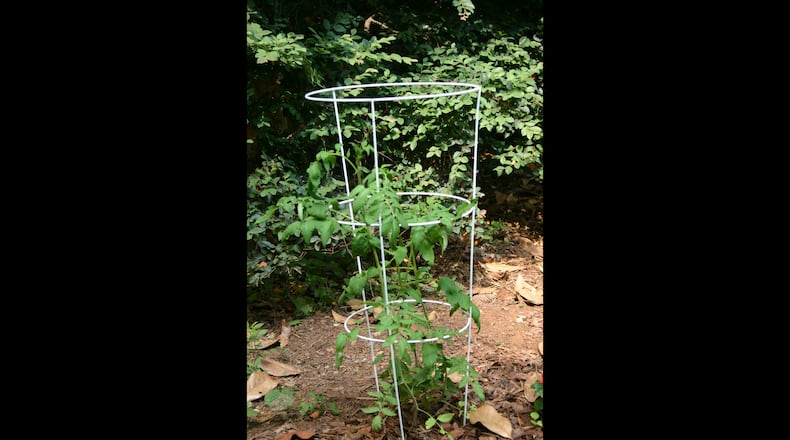Q: How can I clean my tomato cages to make sure I don’t carry any diseases from my community garden plot to my new backyard garden? Paul LaPerre‚ Stone Mountain
A: Early blight, late blight and bacterial wilt diseases can be carried over on tomato cages each year. It is easy to clean cages in three steps: Use a scrub brush and soapy water to remove any dirt on the cages. Organic matter stuck to the cage can harbor disease otherwise. Make a solution of one part bleach to nine parts water and spray it liberally onto cage structures. Bleach kills most fungi and bacteria. Wrap the cages completely with clear plastic sheet and leave them in the sun for a week. The resulting heat inside will be sufficient to kill anything else living in there.
Q: I have a 10-foot-tall ficus tree that has become super top-heavy. I’d rather it be no taller than head high. Would I kill it by pruning that much? Susan Powell, Buford
A: Ficus trees have an amazing ability to regrow after pruning, so I think you can be successful. It’s important to remember that new sprouts will only occur within 6 inches below any cut you make. So if you want a full head of greenery that is only 6 feet high, you need to make your pruning cut 3 or 4 feet from the floor. The best time to do this is in spring when it is warm enough to leave your ficus outdoors overnight in a place where it gets bright shade during the day. When new sprouts start growing, give it houseplant fertilizer. Repeat in July. Water when the soil is dry. I think you’ll have a nice-looking plant when you bring it indoors in October.
Q: I have had some trees cut and the stumps ground. The chips were mixed into the surrounding dirt. Can I lay new zoysia sod there? Larry McCreary, Marietta
A: Your new sod is going to want plenty of nitrogen fertilizer as it grows. Unfortunately, fungi and bacteria in the soil also need nitrogen to break down the wood chips. When the chips are fully decomposed, the nitrogen will be released, but that could be a couple of years from now. If you plant sod, it will be light yellow until then. You can fix that situation by scattering a pint of 10-10-10 fertilizer per 100 square feet in the area where the chips and soil are mixed. Water the spot and wait for the soil to firm up enough to lay sod. The extra fertilizer should satisfy the needs of the bacteria and fungi, and you can fertilize your lawn with turf fertilizer this year as the label directs.
Walter’s email address is georgiagardener@yahoo.com. Listen to his comments at 6:35 a.m. on “Green and Growing with Ashley Frasca” Saturday mornings on 95.5 WSB. Visit his website, www.walterreeves.com, follow him on Twitter @walterreeves, on Pinterest, or join his Facebook Page at bit.ly/georgiagardener.
About the Author
The Latest
Featured

